
The Suburban Golf Course, Reconsidered For The Age Of Climate Change
How a community of civic-minded Texans filed a lawsuit to halt real-estate development on a golf course, then took action to transform it into a 200-acre, flood-resistant conservancy.
Less than four years ago, the golf course at the center of Clear Lake City, Texas, looked like any other suburban golf course, with vast tracts of meticulously manicured lawns stretched across 178 acres of rolling hills. Golf courses are one of the least sustainable uses of urban green space, and like any of the thousands of golf courses scattered throughout the U.S.—which make up a whopping 45% of golf courses worldwide—Clear Lake City’s required an inordinate amount of water for maintenance and upkeep. But today, the golf course is something else entirely: a glimpse at the future of climate change resilience.
With an ongoing, five-phase project called Exploration Green, Clear Lake City has begun to transform the former country club into a network of engineered, flood-detention ponds designed to accommodate an estimated half billion gallons of stormwater. Each of the ponds, which will undergo fine grading and erosion control, will act as giant, slow-draining landing basins to harness water and mitigate flooding to immediate areas.
The new systems will greatly expand upon the city’s preexisting drainage ditches, which have long proved insufficient for the town’s explosion of development and growth in recent decades, and overwhelmed communities downstream during heavy rainfalls. Working to accommodate water rather than blockade it, Clear Lake City’s residents are embracing a strategy of learning to live with nature—a tactic that the Dutch have been known to practice to great success. When completed, the Clear Lake City Water Authority (CLCWA) will have essentially retrofitted the city’s existing landscape to withstand a 100-year storm event.
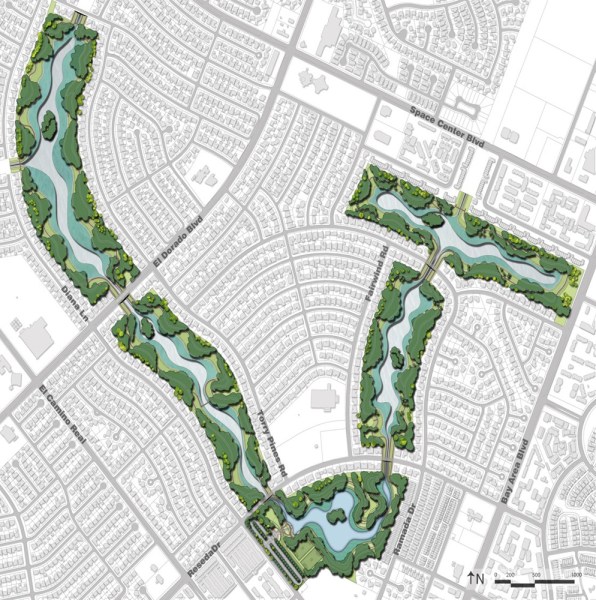
A PRESSING NEED
Last August, Hurricane Harvey swept through the region, dropping upwards of 60 inches of rainfall and causing an estimated $125 billion of damage. It was the second most destructive hurricane in the U.S. on record, after Katrina. Luckily for the citizens of Clear Lake City, Phase 1 of Exploration Green was nearing completion—and saved nearly 200 homes that would have otherwise flooded. After witnessing its success, the CLCWA took steps to aggressively fast-track its initial 15-year project timeline to just five years, with one 100,000-acre detention pond to be completed per year. When all five phases of Exploration Green are completed in 2022, the revamped green space is projected to protect more than 2,000 flood-prone homes from heavy rains and stormwater runoff.
Climate change is here. Cities need to adapt—and faster than they realize, with lean solutions that, like Exploration Green, make use of existing infrastructure. Here’s what Clear Lake City is doing to make resiliency a reality—and what other flood-prone cities could learn.
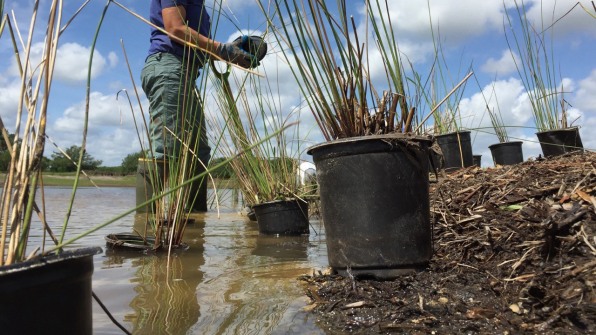
A GRASSROOTS EFFORT
The long saga of reclaiming the golf course began in 2005, when its owner, Renaissance Golf Group LLC, looked to sell the land to residential and commercial developers for a hefty profit. Shuttered for nearly a decade after losing popularity over the years, the golf course had already become a de facto park for local residents.
Wary of recent overdevelopment and increasing flood risk in the community, the city’s residents approached the CLCWA to see what could be done. The water authority, in turn, hired two hydrologists to survey the property “to see how potential development would affect flooding,” says board president John Branch. After determining that paving the green space would significantly increase flooding, Branch, the water authority, and a team of community members began a battle to acquire the land and halt further development.
When the owners denied the CLCWA’s offer to purchase the golf course, they had the land publicly condemned and took it to court, in a case that motioned through the local court system, and up to the appellate circuit. “An appeal would have gone up to the State Supreme Court,” says Branch, “at which point the seller decided he’d rather cut his losses and go ahead and sell it to us.”
In 2011, the CLCWA successfully acquired the land for $6.2 million—significantly below its real estate appraisal that reached as high as $15 million. Through a series of Town Hall meetings that followed, the idea for Exploration Green was born. The water authority hired Houston-based landscape architecture and urban design firm SWA Group—which has worked on local projects including Buffalo Bayou and Hermann Park—to create a master plan for a newly converted green space encompassing permanent water storage, as well as wetlands, and native habitats that will serve as a year-round park for residents.
As Branch attests, forming the idea for Exploration Green and getting it off the ground would not have been possible without enthusiastic involvement from the community—many whom are longtime employees, colleagues, and contractors of the nearby NASA Johnson Space Center (which opened in 1973), and the various aerospace engineering, biochemical, and petrochemical industries also stationed in proximity. “I’m a former Shell employee and can bring in some engineering tech knowledge from a different industry,” says Branch, “but most everyone else on the board are NASA employees or contractors.”
While not all residents have rallied behind the effort (a small number of them convened in 2013 to form the organization Friends of the Old Golf Course, in opposition), it has largely been supported by a majority consensus through the Town Hall meetings. Exploration Green, Branch explains, is named to nod to the community’s collective ties to pioneering science efforts, as well as to Houston’s urban park, Discovery Green.
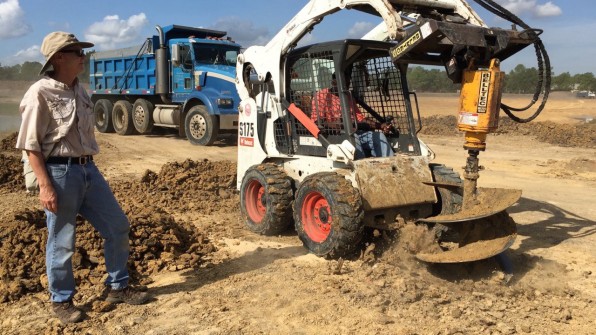
AN ENGINEERED LANDSCAPE
When Clear Lake City—a master-planned, residential community on the south-eastern edge of Houston, and the first of its kind to be built in Texas—was first developed in 1963, its design placed a golf course at the center of the community. Five decades on, the centralized green space, which snakes throughout the community, has proved to be a unique boon to Exploration Green. Crucially, because the community was also developed before there were any existing water, sewage, or drainage facilities in place, Clear Lake City—and its water systems, administered under CLCWA—holds infrastructural autonomy from the city of Houston.
This proved beneficial for the CLCWA, which was able to more nimbly begin construction efforts, notes Kelly Shipley, an associate project manager of Lockwood, Andrews, & Newnam Inc., the firm that is design engineering the project and overseeing construction. “The area was built before detention requirements existed, so there was nothing there,” says Branch. “But because [the golf course] was open green space,” she adds, “it had absorbed a lot of the rainwater,” making it an ideal site for detention ponds.
“The goal of Harris County’s Flood Control is to get water off the streets and out of the area—so their existing drainage channels are made to do that,” Shipley explains. “What Clear Lake is doing is converting those channels into city detention ponds, which, instead of turning the water out, will slow it down, and allow more time for the water to get back out into the bayous and the Gulf. It’s retaining water, and providing a place for that water to go and prevent it from flooding people downstream.”
Engineering each of the detention ponds will require a huge excavation effort, and the team estimates the removal of more than 200,000 dump trucks of soil over the course of the project, a logistical demand that played a large factor in determining feasibility for an expedited completion schedule. The nearly 340,00 cubic yards of soil that have been excavated thus far for Phase 1, Branch said, has been sold to a nearby development to use as fill.
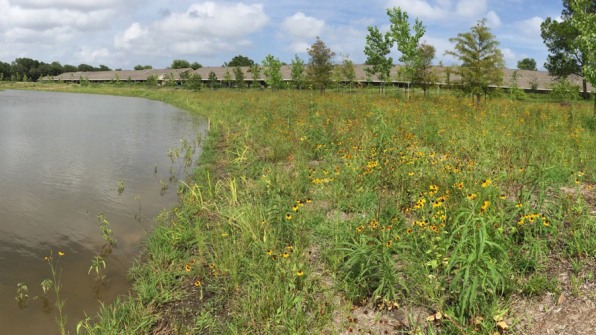
MORE THAN A SEASONAL SOLUTION, A YEAR-ROUND AMENITY
The strategy of building to accommodate storm runoff, rather than blockade or banish it, is core to Exploration Green—and as part of that, the community has also taken steps to ensure the place can double as a park for the vast majority of the year when it’s not storm season.
“We kind of looked around and said, ‘Hey, we don’t want it to just be a big hole in the ground with a fence around,’” says Branch. “We wanted it to be something special and kind of the same flavor of a green open space that could be used by the community.”
To that point, each of the detention ponds will maintain an amount of water year-round to create the feeling of a natural lake, surrounded by six miles of recreational hiking and bicycling trails. While the CLCWA will continue to administer the construction and maintenance of Exploration Green, the Explorer Green Conservancy—a non-profit entity formed by residents and volunteers—will spearhead fundraising and restoration efforts to bring native wildlife, wetland grasses, and trees to the site. Aside from beautifying the space for day-to-day use, the plantings will also help naturally treat contaminated stormwater before it’s released into the drainage systems and bayous.
Alliances and partnerships with other organizations have followed. Trees for Houston is donating 1,000 young trees for each phase of the project, and the Texas Coastal Watershed Program have provided a grant that will be used to create a wetlands nursery. “We’re also working with the Houston-Galveston Area Council to connect our hike and bike trails to existing trails throughout the county,” Branch says.
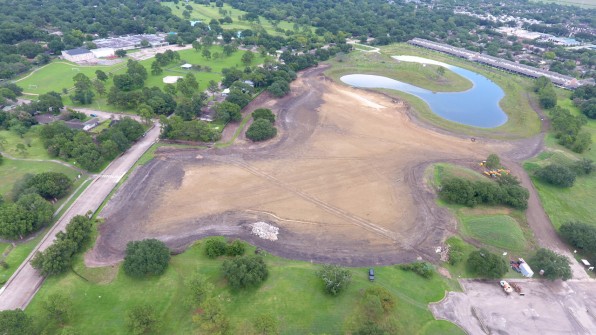
A CASE FOR HOUSTON’S GOLF COURSES
Hurricane Harvey was an important test, and Phase 1 of Exploration Green passed–even as it was under construction.
That empowered the CLCWA to open-source its design on the Exploration Green website, with the hopes that others would be able to benefit from their research. Other flood-prone communities in the Greater Houston region, including Inwood Forest, which was hard hit by Harvey, have already reached out to learn from their model, says Branch, as have various communities from other regions of the country, including Michigan and Virginia.
In a recent study conducted by the University of Houston’s Hobby School of Public Affairs, a majority of more than 2,000 residents polled primarily from Harris County voiced support for tighter building code restrictions and increased infrastructure projects to control flooding. Yet that same group also voiced significant opposition to funding those building measures through a tax hike—emphasizing a problematic divide between reaching a popular consensus, and having the means and agency to address it.
As Branch points out, many of Houston’s golf courses were flooded when Harvey hit the region last August—making Exploration Green an especially relevant case study. While a unique set of advantageous circumstances enabled the residents of Clear Lake City to take direct action on a swift timeline, he believes communities everywhere should feel empowered to engage and bring about direct change in their hometowns.
“We were a government entity, the people here supported us, they wanted something done, and there are a lot of ways to build it,” he added. “But you just can’t sit around waiting for someone else to do something.”

![[Photo: Stan Cook]](https://images.fastcompany.net/image/upload/w_562)